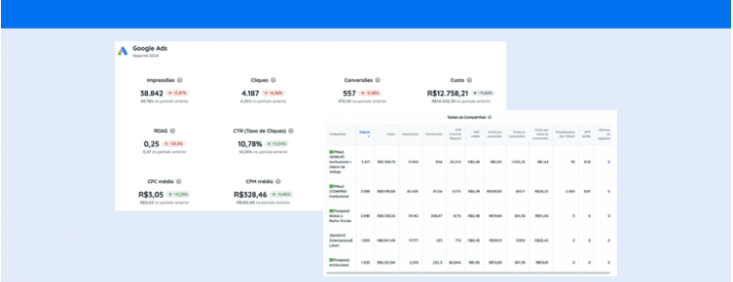Whether it’s for a social media campaign, email marketing, or paid ads, UTM (Urchin Tracking Module) comes into play as an indispensable tool for marketers to measure the success of their initiatives
After all, it’s a method that allows you to track the effectiveness of your online strategies in a detailed and accurate manner. By adding UTM parameters to your website’s URLs, you can gain valuable insights into user behavior, traffic sources, and the performance of each campaign.
So, in this guide, we’ll explore in detail what UTM is, why it’s essential for the success of your marketing campaigns, and how you can analyze it. Read on to find out!
What is UTM?
UTM is a system of parameters that, when added to your website’s URLs, helps monitor the performance of digital marketing campaigns. These parameters are query strings that provide detailed information on the source of traffic, allowing analysts to identify where visitors are coming from and how they interact with content. Hence, UTMs consist of five main parts:
- Source: indicates the origin of the traffic, such as a specific search engine, referral site, or social network;
- Medium: specifies the type of traffic, like a click from an email, an organic social media post, or a paid ad;
- Campaign: identifies the specific campaign being run, like a summer sale promotion or a free webinar;
- Term: mainly used to track paid keywords in online advertising campaigns, indicating which term triggered the click;
- Content: differentiates versions of the same ad or link. For example, if you’re running an A/B test, you can use this parameter to distinguish the different variations of disseminated content.
When a user clicks on a URL with UTM parameters, this information is sent to an analytics tool like Google Analytics, allowing analysts to see exactly where the traffic is coming from and how users interact with the site.
This is crucial for evaluating the effectiveness of digital marketing strategies, understanding which campaigns are more successful, and making informed decisions to optimize performance.
Why Use Trackable URLs in Your Campaigns?
Using trackable URLs in your campaigns offers a host of crucial benefits for any digital marketing strategy. So, here are some reasons to adopt UTMs in your workflow:
- Precise measurement of performance, as they allow you to closely monitor traffic from each source and campaign. You can see which channels are generating the most visitors, where they are clicking, and how long they are staying on your site, to understand the real impact of your campaigns and adjust them as needed;
- Optimization of investments, since you know which campaigns are yielding significant results. By identifying high-quality traffic sources, you can focus your resources in these areas, maximizing Return on Investment (ROI) and avoiding wasted money on less efficient strategies;
- Assessing offline impact: If you work with offline media, like events or print ads, you can create specific trackable URLs for these initiatives and measure the online impact generated by these activities, offering a more comprehensive and integrated view of your marketing;
- Data-driven decision-making from precise and detailed information. This includes adjusting your messaging, optimizing the campaign design, modifying the target audience, and adapting marketing strategies. Data-driven decisions are always more effective than those based on assumptions or gut feelings.
In summary, trackable URLs not only provide valuable information on the performance of your campaigns but also empower you to make the best decisions to boost your online brand success.
How to Create a UTM?
Creating a UTM is a simple process involving adding specific parameters to a URL to track your campaign traffic. Here’s a step-by-step guide to create one:
Define UTM Parameters: Decide what information you want to track, keeping in mind that UTM parameters must at least include Source, Medium, and Campaign, as explained above. Moreover, you can complement information with Term and Content.
Build the URL with UTM Parameters: To create a trackable URL, you just need to add the UTM parameters to the original link, using a question mark (?) to separate each code and an ampersand (&) symbol to separate additional parameters. For example, the URL with UTM parameters would look like this:
example.com/landing-page?utm_source=google&utm_medium=ad&utm_campaign=christmas
In this example, we have:
- Source: Google;
- Medium: Ad;
- Campaign: Christmas.
- Use UTM Building Tools: Lastly, you can use a UTM generator to create your links, without needing to configure the codes manually. Google even offers a free and easy-to-use tool called Campaign URL Builder.
After creating your trackable URL, the tool also allows you to shorten the link so it becomes user-friendly. As it integrates with Bitly, you can even customize this link to suit your needs.
How to Analyze UTM Results in GA4?
As mentioned earlier, analyzing the results generated by your trackable URLs should be done through Google Analytics or another web analytics tool you use. In the case of GA4, the data is available in the Traffic Acquisition tab. When you access this area of the platform, you’ll find a table that shows information on visitor behavior. But to know about specific campaigns, you should select (at the top of the table) options like Session Source/Medium, Session Source, or Session Campaign.
Subsequently, GA4 will update the information, so you can see how many users arrived through the campaign, sessions, engaged sessions, and other metrics that help understand if your action had a positive impact on the project.
Therefore, this step of UTM analysis is crucial for detecting what really works and which campaigns are generating the best return on investment. From this, you can make optimizations that help achieve your marketing goals more easily.
Want to know how to extract the best insights from GA4? Then don’t miss our article: Google Analytics 4 Metrics: Discover the Meaning of the Top 10 Key Metrics.



